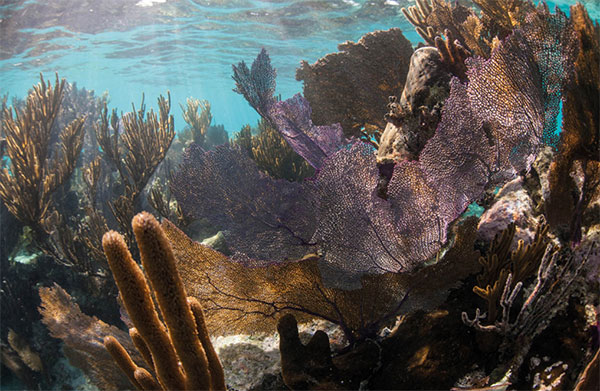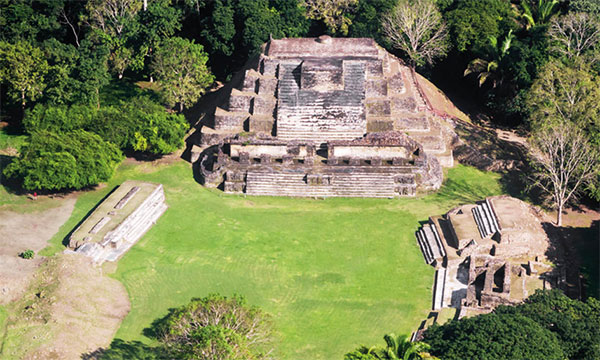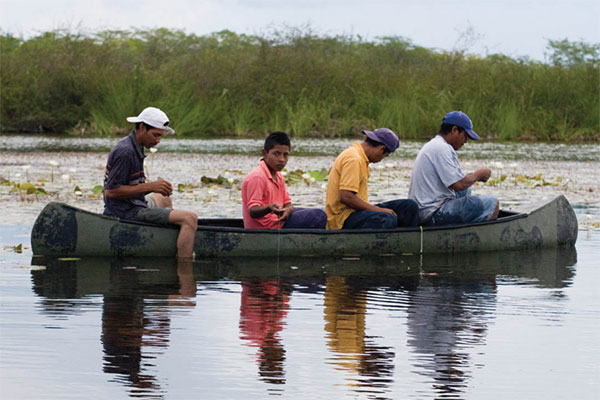Northern Belize
While the rest of Belize, from Cayo to the Cayes, is solidly on the tourist trail, Northern Belize remains largely undiscovered. And that’s a big part of its appeal. This rural, quiet region nudges up against Mexico and is the territory of Latinos or mestizos − Spanish is as common as Creole and there’s a distinctive Latin flair to the villages and towns. The Latin influence is also noticeable in the cuisine, which is a delicious blend of Mexican and Belizean. As for commerce: sugar cane continues to be king and just about every family is either growing it, trucking it, or processing it.
Tourism is a sideline, so you won’t find the eco-lodges of San Ignacio or the lively bars of San Pedro. But if you like your Maya ruins remote and mysterious and your towns and villages untouched and genuine, then you’ll enjoy what sleepy Orange Walk, and even sleepier Corozal, have to offer.

Gorgonians and coral colonies growing on a shallow reef at Turneffe Atoll.
Shutterstock
Community Baboon Sanctuary
Community Baboon Sanctuary 9 [map] (8am–5pm) is one of the most popular and successful conservation projects in Belize. Founded in 1985, the Baboon Sanctuary is a co-operative effort between environmentalists (aided by the World Wildlife Fund under the auspices of the Belize Audubon Society) and local creole landowners to save Central America’s declining population of black howler monkeys, known as baboons in Belize. Apart from Belize, this sub-species is only found in the river lowlands of Guatemala and southern Mexico, where the rainforest has been shrinking at such a rate that extinction was becoming probable.
The sanctuary’s service village is Bermudian Landing, a British logging camp in the 17th century and today a relaxed creole outpost. Check in at the visitors’ center here – there are some places to stay, some flat ground for tents, or the station manager can arrange for accommodations with local families. A small museum, opened in 1989, was Belize’s first devoted to natural history, and an interpretative trail can be followed. Canoe trips, horseback riding, and crocodile-watching tours are also available.
Altun Ha
Whether or not they know the archeologists’ name for it, everyone in Belize recognizes the Temple of Masonry Altars at Altun Ha ) [map] (www.travelbelize.org/attraction/altun-ha; daily 8am–5pm). The image is on the paper money, school textbooks, and perhaps even most importantly for some, it was chosen for the logo of the national beer, Belikin.
Altun Ha, Mayan for ‘stone water,’ was first excavated in 1957, but extensive work did not start until the discovery of a jade pendant in 1963, which excited a great deal more interest. Archeological excavations unearthed a jade replica of the head of the Maya sun god Kinich Ahau, found in the Temple of the Masonry Altars (also known as Temple of the Sun God). At 15cm (6in) high and weighing 4.4kg (9.75lbs), it is the largest carved jade object ever found in the Maya world.
Fact
Jade was the most precious substance to the Maya, as it had been to other pre-Columbian cultures, such as the Olmecs of Mexico. It occurs in various shades, but the Maya prized the green jade most highly, considering it sacred for its glowing green hues that reminded them of the green leaves of maize, their symbol of life itself. For this reason, only kings and deities were allowed to wear jade, as a mark of their status and power.
Altun Ha is made up of two plazas surrounded by temples. Plaza A is the first you come to, and beneath Temple A-1 is a magnificent temple, the Temple of the Green Tomb. More than 300 pieces were unearthed here, including jade, jewelry, flints, and jaguar skins.
Plaza B has the site’s largest temple, B-4, the Temple of the Masonry Altars (which is depicted on the Belikin beer label).
Crooked Tree Wildlife Sanctuary
Due west of Altun Ha on the Philip Goldson (Northern) Highway is a dirt road to the left, leading after 19km (12 miles) to the Crooked Tree Wildlife Sanctuary ! [map] (8am−4.30pm). This string of four lagoons, connected by swamps and rivers, is one of Belize’s richest bird habitats – nesting here are migratory flocks of egrets, tiger-herons, roseate spoonbills, and hundreds of other species. Perhaps the most impressive, although elusive, is the jabiru stork, the largest bird in the Western hemisphere, with a wingspan of up to 2.4 meters (8ft). The wildlife sanctuary was set up by the Belize Audubon Society in 1984 and is now managed by wardens from the village. Before entering, sign in at the tidy visitors’ center, just outside the village of Crooked Tree, one of the first logging camps, founded by British logwood cutters in the 17th century. Before the causeway was built in the 1980s, the only way to get to Crooked Tree was by boat. The lagoon is a natural reservoir in the Belize River Valley and regularly floods in the rainy season.

Altun Ha.
Shutterstock
Fact
Crooked Tree is not only famous for its birds; to Belizeans the name has long been synonymous with cashews – cashew nuts, cashew wine, even stewed cashew fruit. To celebrate this nifty nut, every May the village holds the Cashew Festival. It features nut roasting and every imaginable cashew-based product, as well as local cuisine and music.
The managers of the sanctuary can give you a little local history as well as provide information on nature trails and birdlife. The ideal way to visit is by taking a hired boat trip into the swamps and lagoons (call the visitors’ center or any of the resorts in Crooked Tree). Peak bird-watching season is between April and May, when hatching begins (most migratory birds arrive in November, and many leave before the rainy season starts in July). As usual, start at dusk. There are three daily buses from Belize City, in the morning and afternoon.

Fishing on the New River Lagoon, Lamanai.
Corrie Wingate/Apa Publications